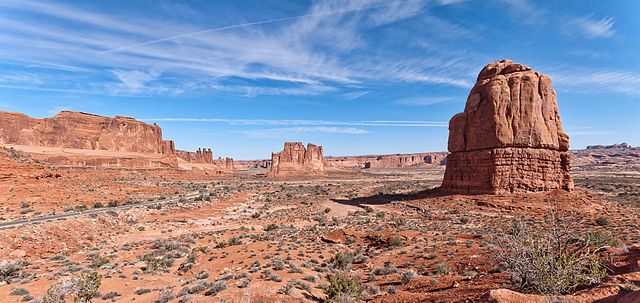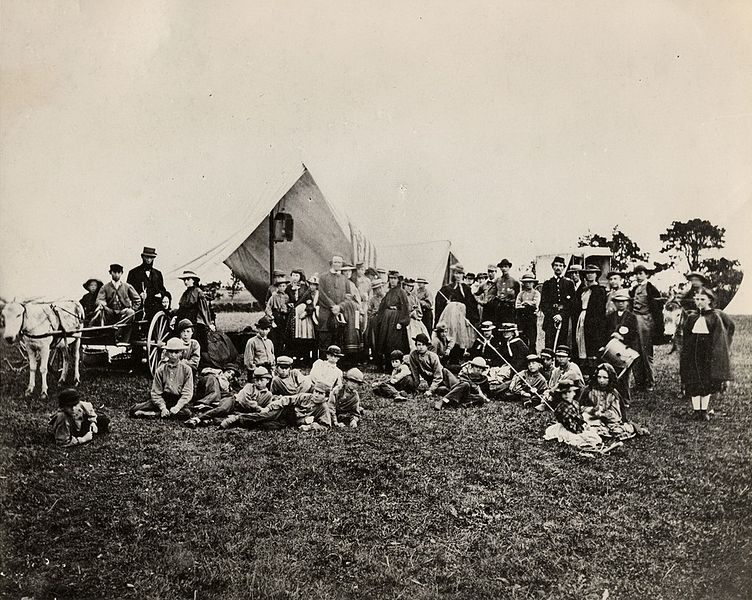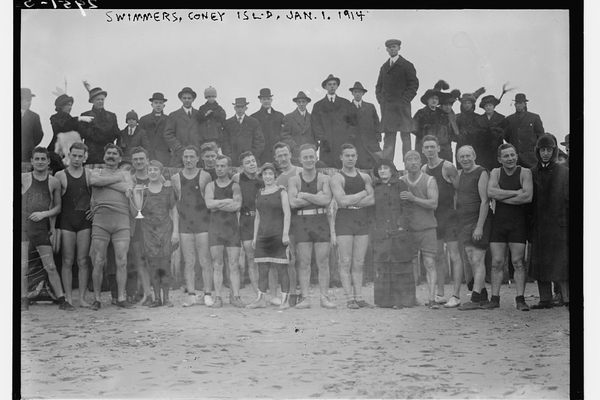‘Wet Hot American Summer’ On a Bus: The Decadent Thrills of Teen Tours
 Arches National Park, one of the many itinerary options for teen tours. (Photo: Jean-Christophe Benoist/WikiCommons CC BY-SA 3.0)
Arches National Park, one of the many itinerary options for teen tours. (Photo: Jean-Christophe Benoist/WikiCommons CC BY-SA 3.0)
For the youth of America, camp has an undeniable allure (the lack of parental supervision looming large). But why spend your whole summer in one bunk when you can stay at four hotels in California, three campsites in Montana and Utah, and a cruise ship in Alaska?
This is the lure of teen tours—the 4-to-6-week luxury trips out West taken every summer by hundreds of kids around the country.
 A photograph from 1861 of Gunnery Camp, the first organized American summer camp. (Photo: Public Domain/WikiCommons)
A photograph from 1861 of Gunnery Camp, the first organized American summer camp. (Photo: Public Domain/WikiCommons)
While nowhere nearly as popular as summer camps, these kinds of teen trips have been around since the mid-1960s. Early teen-tour operators out of Long Island and New Jersey first conceived of these trips as an alternative to sleep-away camps, marketed toward kids who had a thirst for adventure but a distaste for bunk life and athletic activity. American Trails West and Musiker Teen Tours, the first two companies to offer these tours, sent out supervised groups of three-dozen 14-year-olds on coach buses across the country, stopping at the major national parks—from Yellowstone to Arches—and the major resort destinations—from Las Vegas to Palm Springs.
This was not your family’s rustic road trip. Equal in price to the most exclusive sleep-away camps, the tours provided only the best amenities. The trips that did offer camping stays showcased the “five-star” camping experience: giant, 12-person tents filled with double-decker cots. With this set-up, no camper would ever actually have to touch the ground. Accompanying the coach bus with the kids was a food truck, driven and serviced by a cook who prepared all the meals at the campsites.
Compared to today’s cell phone-connected world, these trips operated with a huge amount of freedom. “They gave me a dozen maps of the West and $40,000 worth of Traveler’s Cheques that I carried in a back-pack my father carried in World War II,” says Faith Baron, who guided tours in the 1970s with American Trails West. “The bus rides were fun but endless. Whenever any of the kids asked us how much longer until we got to the next place, we had the same answer: 1,000 miles. No one actually knew. Then we’d stop the bus at a highway stop and buy them ice cream. It was all chaos and we had a blast,” she says.
 One of the hotel options from American Trails West, the Hyatt Regency in Waikiki, Hawaii. (Photo: Prayitno/flickr)
One of the hotel options from American Trails West, the Hyatt Regency in Waikiki, Hawaii. (Photo: Prayitno/flickr)
Forty years later, a small handful of teen-tour operators continue to run annual summer trips out of the New York tri-state area. While Musiker Teen Tours has re-invented itself as Summer Discovery, offering pre-college study abroad programs instead of cross-country trips, originator American Trails West, and a few other almost-as-old companies are still in the teen tour business. They’ve expanded their offerings to now include month-long tours around Europe and combination Alaska-Hawaii trips, but the formula remains the same: take 40 kids to as many places as they can stand in 42 days.
Although variations on the teen tour arose throughout the country in the 1980s and 1990s—shorter, less extravagant trips run by religious and service-oriented organizations—the teen tour, in its original, outsized and deluxe form has remained a tiny industry, with fewer than six or seven operators running trips at a time.
For this reason, the story of the American teen tour is a well-kept secret limited to only the circles of the lucky kids—like myself—who have experienced them. Images and representations of sleep-away camp abound in the collective imagination, a cultural lexicon that includes everything from Meatballs to Salute Your Shorts to an entire genre of 80s slasher films. Where is the Wet Hot American Summer of teen tours? It’s a myth fifty years in the making, waiting to be told.
 Lake Tahoe, another tour offering for teens. (Photo: Lara Farhadi/WikiCommons CC BY 2.0)
Lake Tahoe, another tour offering for teens. (Photo: Lara Farhadi/WikiCommons CC BY 2.0)
Just as sleep-away camps don’t seem to change much over the years, neither do teen tour buses. Listening to Baron recount her trips from the 1970s felt a lot like re-living my own summers as a teen-tour traveler in the early 2000s. She described the same food trucks, the same double-decker cots, the same amusement-park buddy system, the same all-quiet-in-the-morning bus policy I remembered from my trips. On the open road, few things change.
The cast of characters, too, is nearly identical. “We had the kids who wanted to shop and the kids who wanted to hike,” Baron says. The same divide marked all three of my teen tours. With the National Park Passport Book I made sure I had stamped at every park we visited, I was one of the kids who wanted to hike.
 Yellowstone National Park. (Photo: Karthikc123/WikiCommons CC BY-SA 3.0)
Yellowstone National Park. (Photo: Karthikc123/WikiCommons CC BY-SA 3.0)
“On every trip I went on, we had to send at least one kid home,” Baron says. I remember vividly the delinquents from my own trips. On my first trip, it was the boy who threw water balloons off a hotel balcony in Seattle. On my second trip, it was the girl who got caught smoking something you can’t buy at a road-stop convenience store. Maybe the author of the 1988 guide, Summer Camps and Teen Tours: Everything Parents and Kids Should Know,was onto something: “If your child has difficulty following instructions, if he has a long history of spending his school days in the principal’s office, if you know that he has been abusing drugs, a teen tour is not the place for him.”
What would the Meatballs of teen tours look like? Take all those uncomfortable, charming, weird mid-adolescents of Wet Hot American Summer and put them on an air-conditioned bus to a rodeo in Cody, Wyoming or a ski resort in Whistler. It’s not so much a camp experience as it as a family vacation with no one you’re actually related to. There are all the emotional milestones of sleep-away camp—it’s fun when you’re there, sad when it’s over, melancholy and strange when you think about it years later—but there’s something else, too. It’s that combination of wanderlust and boredom you can only find on a teen tour bus.














Follow us on Twitter to get the latest on the world's hidden wonders.
Like us on Facebook to get the latest on the world's hidden wonders.
Follow us on Twitter Like us on Facebook